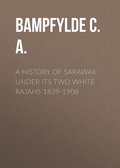
Baring-Gould Sabine
Historic Oddities and Strange Events
John Stauff's arrest took place on November 3, 1847, four months and a half after the death of the Countess. He was, however, only arrested on a charge of attempting to poison the Count, and the further charge of having murdered the Countess was not brought against him till August 28, 1848. The body of the murdered woman, it will be remembered, was not exhumed and examined till August 11, 1848 – eight months after the re-opening of the investigation! It is really wonderful that the mystery should have been cleared and the Count's character satisfactorily vindicated, with such dilatoriness of proceeding. One more instance of the stupid way in which the whole thing was managed. Although John Stauff was charged with the attempt to poison on November 3, 1847, he was not questioned on the charge till January 10, 1849, that is, till he had been fourteen months in prison.
It will be remembered that the bell-rope in the Countess's parlour was torn down. It would suggest itself to the meanest capacity that here was a point of departure for inquiry. If the bell had been torn down, it must have pealed its summons for help through the house. Who was in the house at the time? If anyone was, why did he not answer the appeal? Inconceivable was the neglect of the magistrates of Darmstadt in the first examination – they did not inquire. Only several months later was this matter subjected to investigation.
In the house lived the Count and Countess, the cook, who also acted as chambermaid to the Countess, Schiller, the valet to the Count, Schämbs, the coachman, and the Countess's own servant-man, John Stauff. Of these Schiller and Schämbs did not sleep in the house.
June 13, the day of the murder, was a Sunday. The Count went as usual to the grand-ducal palace in his coach at 3 P.M. The coachman drove him; Stauff sat on the box beside the coachman. They left the Count at the palace and returned home. They were ordered to return to the palace to fetch him at 6 P.M. On Sundays, the Count usually spent his day in his own suite of apartments, and the Countess in hers. On the morning in question she had come downstairs to her husband with a bundle of coupons which she wanted him to cash for her on the morrow. He managed her fortune for her. The sum was small, only £30. At 2 P.M. she went to the kitchen to tell the cook she might go out for the afternoon, as she would not be wanted, and that she must return by 9 P.M.
At three o'clock the cook left. The cook saw and spoke to her as she left. The Countess was then partially undressed, and the cook supposed she was changing her clothes. Shortly after this, Schiller, the Count's valet, saw and spoke with her. She was then upstairs in the laundry arranging the linen for the mangle. She was then in her morning cotton dress. Consequently she had not dressed herself to go out, as the cook supposed. At the same time the carriage left the court of the house for the palace. That was the last seen of her alive, except by John Stauff, and, if he was not the murderer, by one other.
About a quarter past three the coach returned with Schämbs and Stauff on the box. The Count had been left at the palace. The coachman took out his horses, without unharnessing them, and left for his own house, at half-past three, to remain there till 5 o'clock, when he must return, put the horses in, and drive back to the palace to fetch the Count. A quarter of an hour after the coachman left, Schiller went out for a walk with his little boy.
Consequently – none were in the house but the Countess and Stauff, and Stauff knew that the house was clear till 5 o'clock, when Schämbs would return to the stables. What happened during that time?
At a quarter past four, the wife of Schiller came to the house with a little child, and a stocking she was knitting. She wanted to know if her husband had gone with the boy to Eberstadt, a place about four miles distant. She went to the back-door. It was not fastened, but on being opened rang a bell, like a shop door. Near it were two rooms, one occupied by Schiller, the other by Stauff. The wife went into her husband's room and found it empty. Then she went into that of Stauff. It also was empty. She returned into the entrance hall and listened. Everything was still in the house. She stood there some little while knitting and listening. Presently she heard steps descending the backstairs, and saw Stauff, with an apron about him, and a duster in his hand. She asked him if her husband had gone to Eberstadt, and he said that he had. Then she left the house. Stauff, however, called to her from the window to hold up the child to him, to kiss. She did so, and then departed.
Shortly after five, Schämbs returned to the stable, put in the horses, and drove to the palace without seeing Stauff. He thought nothing of this, as Stauff usually followed on foot, in time to open the coach door for the Count. On this occasion, Stauff appeared at his post in livery, at a quarter to six. At half-past six both returned with their master to the house in Neckar Street.
Accordingly, from half-past three to a quarter past four, and from half-past four to half-past five, Stauff was alone in the house with the Countess. But then, from a quarter to five to half-past five she was quite alone, and it was possible that the murder was committed at that time. The Count, it will be remembered, on his return, went upstairs and knocked at the door of the Countess' apartments, without meeting with a response. Probably, therefore, she was then dead.
At seven o'clock the coachman went away, and Stauff helped the Count to take off his court dining dress, and put on a light suit. He was with him till half-past seven, when the Count went out for a walk. The Count returned at half-past eight; during an hour, therefore, Stauff was alone in the house with the Countess, or – her corpse.
What occurred during that hour? Here two independent pieces of evidence come in to assist us in determining what took place. At five minutes past eight, Colonel von Stockhausen had seen the column of black smoke issue from the chimney of the house; it ascended, he said, some fifteen feet above the chimney, and was so dense that it riveted his attention whilst he was talking to a lady.
At about a quarter-past eight the smoke ceased.
The reader may remember that the window of the inner boudoir did not look into the Neckar Street, but into a small side street. Immediately opposite lived a widow lady named Kekule. On the evening in question, her daughter, Augusta, a girl of eighteen, came in from a walk, and went upstairs to the room the window of which was exactly opposite, though at a somewhat higher level than the window of the boudoir. Looking out of her window, Augusta Kekule saw to her astonishment a flickering light like a lambent flame in the boudoir. A blind was down, so that she could see nothing distinctly. She was, however, alarmed, and called her brother Augustus, aged twenty years, and both watched the flames flashing in the room. They called their mother also, and all three saw it flare up high, then decrease, and go out. The time was 8.15. On examination of the spot, it was seen that the window of Miss Kekule commanded the corner of the boudoir, where was the divan partly burnt through in several places.
What was the meaning of these two appearances, the smoke and the flame? Apparently, from half-past seven to half-past eight the murderer was engaged in burning the body, and in effacing with fire the blood-stains on the sofas. During this time John Stauff was in the house, and, beside the Countess, alive or dead, John Stauff only.
Stauff was now subjected to examination. He was required to account for his time on the afternoon and evening of Sunday, June 13.
He said, that after his return from the palace, that is, about ten minutes past three, he went into his room on the basement, and ate bread and cheese. When told that the wife of Schiller stated she had seen him come downstairs, he admitted that he had run upstairs to fetch a duster, to brush away the bread crumbs from the table at which he had eaten. After the woman left, according to his own account, he remained in his room below till five o'clock, when the Countess came to the head of the stairs and called him. He went up and found her on the topmost landing; she went into the laundry, and he stood in the door whilst she spoke to him, and gave him some orders for the butcher and baker. She wore, he said, a black stuff gown. Whilst he was talking to her, Schämbs drove away to fetch the Count. He gave a correct account of what followed, up to the departure of the Count on his walk. After that, he said, he had written a letter to his sweetheart, and at eight went out to get his supper at an outdoor restaurant where he remained till half-past nine. He was unable to produce evidence of anyone who had seen him and spoken to him there; but, of course, much cannot be made of this, owing to the distance of time at which the evidence was taken from the event of the murder. According to his account, therefore, no one was in the house at the time when the smoke rose from the chimney, and the flame was seen in the boudoir.
If we sum up the points determined concerning the murder of the Countess, we shall see how heavily the evidence told against Stauff.
She had been attacked in her room, and after a desperate struggle, which went on in both parlour and boudoir, she had been killed.
Her secretaire had been robbed.
Her body had been burnt.
The blood-stains had been effaced by fire.
The secretaire had been set fire to; and, apparently, the body removed from where it had been partially consumed, and placed near it.
Now all this must have taken time. It could only be done by one who knew that he had time in which to effect it undisturbed.
John Stauff was at two separate times, in the afternoon and evening, alone in the house for an hour, knowing that during that time he would be undisturbed.
If his account were true, the murder must have been committed during his brief absence with the coach, and the burning of the body, and setting fire to the room, done when he went out to get his supper. But – how could the murderer suppose he would leave the house open and unprotected at eight o'clock? Was it likely that a murderer and robber, after having killed the Countess and taken her jewels at six o'clock, would hang about till eight, waiting the chance of getting back to the scene of his crime unobserved, to attempt to disguise it? not knowing, moreover, how much time he would have for effecting his purpose?
It was possible that this had been done, but it was not probable.
Evidence was forthcoming from a new quarter that served to establish the guilt of Stauff.
On October 6, 1847, an oilman, Henry Stauff, in Oberohmen, in Hesse Cassel, was arrested, because he was found to be disposing of several articles of jewelry, without being able to give a satisfactory account of where he got them. The jewelry consisted of a lump of molten gold, and some brooches, bracelets and rings.
Henry Stauff had been a whitesmith in his youth, then he became a carrier, but in the last few years, since the death of his wife, he had sold knives, and been a knife-grinder. He was very poor, and had been unable to pay his rates. In July of 1847, however, his affairs seemed to have mended; he wore a silver watch, and took out a licence to deal in oil and seeds. When he applied for the patent, the burgomaster was surprised, and asked him how he could get stock to set up business, in his state of poverty. Thereupon, Henry Stauff opened his purse and showed that it contained a good amount of silver, and – with the coins was a gold ring with, apparently, a precious stone in it.
The cause of his arrest was his offering the lump of gold to a silversmith in Cassel. It looked so much as if it was the melting up of jewelry, that the smith communicated with the police. On his arrest, Henry Stauff said he was the father of four children, two sons and two daughters; that his sons, one of whom was in the army, had sent him money, that his daughter in America had given him the jewelry, and that the gold he had had by him for several years, it had been given him by a widow, who was dead. The silver watch he had bought in Frankfort. Henry Stauff had a daughter at home, name Anna Margaretta, who often received letters from Darmstadt. One of these letters had not been stamped, and as she declined to pay double for it, it lay in the post-office till opened to be returned. Then it was found to be dated September 29, 1847, and to be from her brother, John Stauff. It simply contained an inclosure to her father; this was opened; it contained an angry remonstrance with him for not having done what he was required, and sent the money at once to the writer.
Was it possible that this had reference to the disposal of the jewelry?
On July 7, three weeks after the death of the Countess, Henry Stauff was at Darmstadt, where one son, Jacob, was in the army; the other, John, was in service with the Goerlitz family.
This led the magistrates in Cassel to communicate with those in Darmstadt. On November 10, John Stauff was questioned with reference to his father. He said he had often sent him money. He was shown the jewelry, and asked if he recognised it. He denied having ever seen it, and having sent it to his father.
The jewelry was shown to Count Goerlitz, and he immediately identified it as having belonged to his wife. A former lady's-maid of the Countess also identified the articles. The Count, and a maid, asserted that these articles had always been kept by the deceased lady in the small upper drawers of her secretaire. The Countess was vain and miserly, and often looked over her jewelry. She would, certainly, have missed her things had they been stolen before June 13.
The articles had not been stolen since, found among the ashes, and carried off surreptitiously, for they showed no trace of fire.
Here we must again remark on the extraordinary character of the proceedings in this case. The articles were identified and shown to John Stauff on November 10, 1847, but it was not till ten months after, on August 28, 1848, that he was told that he was suspected of the murder of the Countess, and of having robbed her of these ornaments. Another of the eccentricities of the administration of justice in Darmstadt consisted in allowing the father Henry, and his son John, to have free private communication with each other, whilst the latter was in prison, and thus allowing them to concoct together a plausible account of their conduct, with which, however, we need not trouble ourselves.
On September 1, 1848, on the fourth day after Stauff knew that he was charged with the murder of the Countess, he asked to make his statement of what really took place. This was the account he gave. It will be seen that, from the moment he knew the charge of murder was brought against him, he altered his defence.
He said, "On June 20, 1847," (that is, a week after the murder), "about ten o'clock in the evening, after the Count had partaken of his supper and undressed, he brought me a box containing jewelry, and told me he would give it to me, as I was so poor, and that it would place my father and me in comfortable circumstances. I then told the Count that I did not know what to do with these jewels, whereupon he exhorted me to send them to my father, and get him to dispose of them. He told me that he required me solemnly to swear that I would not tell anyone about the jewels. I hid the box in a stocking and concealed it in some bushes on the Bessungen road. Later I told my brother Jacob where they were, and bade him give them to my father on his visit to Darmstadt."
When Stauff was asked what reason he could assign for the Count giving him the jewels, he said that the Count saw that he, John Stauff, suspected him of the murder, and he named several circumstances, such as observing blood on the Count's handkerchief on the evening of the murder, which had led him to believe that the Count was guilty, and the Count was aware of his suspicions.
On March 4, 1850, began the trial of John Stauff for the murder of the Countess, for robbery, for arson, and for attempt to poison the Count.
At the same time his father, Henry Stauff, and his brother, Jacob Stauff, were tried for concealment of stolen goods. The trial came to an end on April 11. As many as 118 witnesses were heard; among these was the Count Goerlitz, as to whose innocence no further doubts were entertained.
John Stauff was at that time aged twenty-six, he was therefore twenty-four years old at the time of the murder. He had been at school at Oberohmen, where he had shown himself an apt and intelligent scholar. In 1844 he had entered the grand-ducal army, and in May 1846 had become servant in the Goerlitz house, as footman to the Countess. In his regiment he had behaved well; he had been accounted an excellent servant, and both his master and mistress placed confidence in him. Curiously enough, in the autumn of 1846, he had expressed a wish to a chambermaid of the Countess "that both the Countess and her pack of jewels, bracelets and all, might be burnt in one heap."
When the maid heard of the death of the Countess in the following year, "Ah!" she said, "now Stauff's wish has been fulfilled to the letter."
He was fond of talking of religion, and had the character among his fellow-servants of being pious. He was, however, deep in debt, and associated with women of bad character. Throughout the trial he maintained his composure, his lips closed, his colour pale, without token of agitation. But the man who could have stood by without showing emotion at the opening of the coffin of his mistress, at the sight of the half-burnt, half-decomposed remains of his victim, must have had powers of self-control of no ordinary description. During the trial he seemed determined to show that he was a man of some culture; he exhibited ease of manner and courtesy towards judges, jury, and lawyers. He never interrupted a witness, and when he questioned them, did so with intelligence and moderation. He often looked at the public, especially the women, who attended in great numbers, watching the effect of the evidence on their minds. When, as now and then happened, some ludicrous incident occurred, he laughed over it as heartily as the most innocent looker-on.
The jury unanimously found him "guilty" on every count. They unanimously gave a verdict of "guilty" against his father and brother. Henry Stauff was sentenced to six months' imprisonment; Jacob Stauff to detention for three months, and John to imprisonment for life. At that time capital punishment could not be inflicted in Hesse.
On June 3, he was taken to the convict prison of Marienschloss. On July 1, he appealed to the Grand-Duke to give him a free pardon, as he was innocent of the crimes for which he was sentenced. The appeal was rejected. Then he professed his intention of making full confession. He asked to see the Count. He professed himself a broken-hearted penitent, desirous of undoing, by a sincere confession, as much of the evil as was possible.
We will give his confession in his own words.
"When, at five o'clock, I went to announce to the Countess that I was about to go to the palace, I found both the glass door of the ante-room, and that into the sitting-room, open, and I walked in through them. I did not find the Countess in her parlour, of which the curtains were drawn. Nor was she in her boudoir. I saw the door into the little corner room ajar, so I presumed she was in there. The flap of her desk was down, so that I saw the little drawers, in which I knew she kept her valuables, accessible to my hand. Opportunity makes the thief. I was unable to resist the temptation to enrich myself by these precious articles. I opened one of the drawers, took out a gold bracelet, one of gold filigree, two of bronze, a pair of gold ear-rings, a gold brooch, and a triple chain of beads or Roman pearls; and pocketed these articles, which my father afterwards had, and, for the most part, melted up.
"Most of these articles were in their cases. At that moment the Countess appeared on the threshold of her boudoir and rushed towards me. I do not remember what she exclaimed; fear for the consequences, and anxiety to prevent the Countess from making a noise and calling assistance, and thereby obtaining my arrest, prevailed in my mind, and I thought only how I might save myself. I grasped her by the neck, and pressed my thumbs into her throat. She struggled desperately. I was obliged to use all my strength to hold her. After a wrestle of between five and seven minutes, her eyes closed, her face became purple, and I felt her limbs relax.
"When I saw she was dead I was overcome with terror. I let the body fall, whereby the head struck the corner of the left side of the secretaire, and this made a wound which began to bleed. Then I ran and locked both the doors, hid what I had taken in my bed, and left the house. On my way to the palace, I stepped into Frey's tavern and drank three glasses of wine. I was afraid I should arrive too late at the palace, where I appeared, however, at half-past five. The Count did not return till half-past six, as dinner that day lasted rather longer than usual.
"When the Count went upstairs to see his wife and take her something good he had brought away with him from table, I was not uneasy at all, for I knew that he would knock and come away if he met with no response. So he did. He came down without being discomposed, and remarked that he fancied the Countess had gone out. At half-past seven he left the house. In the mean time I had been considering what to do, and had formed my plan. Now my opportunity had arrived, and I hastened to put it into execution. My plan was to efface every trace of my deed by fire, and to commit suicide if interrupted.
"As the weather was chilly, the Count had some fire in his stove. I fetched the still glowing charcoal, collected splinters of firwood and other combustibles, and matches, and went upstairs with them. Only the wine sustained me through what I carried out. I took up the body. I put a chair before the open desk, seated the corpse on it, placed one arm on the desk, laid the head on the arm, so that the body reposed in a position of sleep, leaning on the flap of the desk. I threw the red hot charcoal down under the head, heaped matches, paper, and wood splinters over them; took one of the blazing bits of wood and threw it on the divan in the boudoir; locked both doors, and flung away the keys.
"Then I went to my own room and lighted a fire in the stove, and put the jewel cases on the fire. The fire would not burn well, and thick smoke came into the room. Then I saw that the damper was closed. I opened that, and the smoke flew up the chimney; this is what Colonel von Stockhausen saw. There were a lot of empty match-boxes also in the stove, and these burnt with the rest."
Such was the confession of Stauff. How far true, it is impossible to say. He said nothing about the bell-pull being torn down, nothing about the holes burnt in the sofa of the sitting-room. According to the opinion of some experimentalists, the way in which he pretended to have burnt the Countess would not account for the appearance of the corpse.
His object was to represent himself as the victim of an over-mastering temptation – to show that the crime was wholly unpremeditated.
This was the sole plea on which he could appeal for sympathy, and expect a relaxation of his sentence.
That sentence was relaxed.
In 1872 he obtained a free pardon from the Grand-Duke, on condition that he left the country and settled in America. Including his imprisonment before his trial, he had, therefore, undergone twenty-five years of incarceration.
When released he went to America, where he probably still is.







